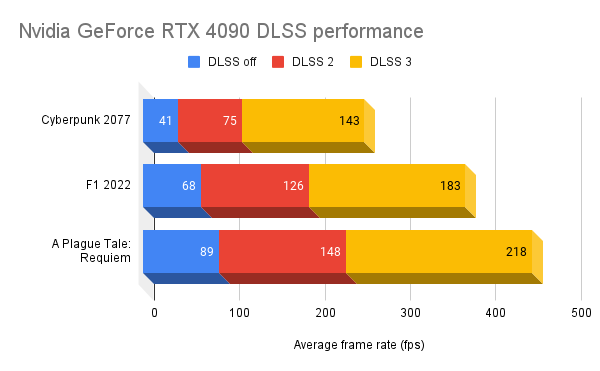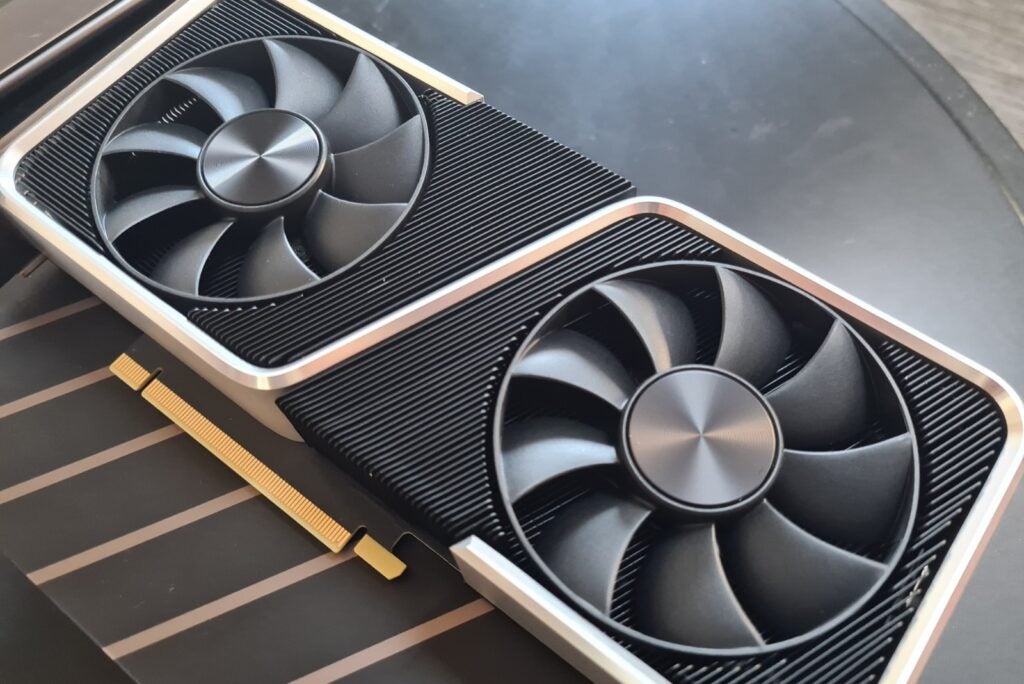
OPINION: For the past couple of weeks, I’ve been testing the Nvidia GeForce RTX 4090 graphics card, the very first GPU to ship from the new RTX 4000 Series with Lovelace architecture.
While the raw performance is incredibly impressive, one of the standout features of this behemoth is the support for the cutting-edge DLSS 3 technology.
By using incredibly clever artificial intelligence, DLSS 3 can create additional frames as you play a game. This reduces the workload of your GPU and therefore boosts the framerate performance of supported games.
I tested out the technology with three games – Cyberpunk 2077, F1 2022 and A Plague Tale: Requiem – with a 4K resolution and ray tracing activated. You can check out the results below, and how it compares to DLSS 2 and a native performance:

DLSS 3 resulted in a jaw-dropping 249% frame rate boost for Cyberpunk, resulting in an average 143fps performance compared to 41fps with native settings.
But as impressive as DLSS 3 is here, it’s hard to get too excited when the RTX 4090 can already run the vast majority of games at a high frame rate, even with maxed out graphics settings.
My benchmark results show that the RTX 4090 can play Horizon Zero Dawn, Borderlands 3, Total War: Warhammer 3 and Overwatch 2 at a frame rate beyond 100fps, even when set to a 4K resolution.
And as the excellent team over at Digital Foundry has discovered, DLSS 3 can occasionally cause distracting artefacts and latency issues. Those are minor compromises to accept if it enables you to play the latest games at a playable framerate in 4K, but there’s little point in making such compromises when your graphics card (such as the RTX 4090) is already capable of a high-end performance without DLSS.
With all of that taken into account, I believe we won’t really see the true value of DLSS 3 until Nvidia launches an RTX 4060 graphics card.
The xx60 series is one of the most popular Nvidia graphics card options. According to a Steam hardware survey, the Nvidia GTX 1060 was the most used graphics card in September 2022. The RTX 2060 came in third place, while the RTX 3060 ranked seventh.
This is likely because the xx60 series generally has an affordable price point. Both the RTX 2060 and RTX 3060 can be purchased for around $300/£300, making them significantly cheaper options than the $1599/£1679 Nvidia RTX 4090 card.
They offer a great performance too. When testing the RTX 3060 Ti, we were able to play Horizon Zero Dawn at 86fps in 1440p, and Borderlands 3 at 68fps set to the same resolution.
The RTX 3060 Ti wasn’t so impressive when asked to run games at a 4K resolution. It only managed a 15fps performance for Control and a 23fps performance for Battlefield V. DLSS did manage to provide a performance boost for both games, hiking up to 40fps for Control and 41fps for Battlefield V, but that’s still not quite high enough to ensure a smooth performance.

If DLSS 3 proves to be as efficient on the RTX 4060 series as it was on the RTX 4090, the affordable graphics card should – in theory – be able to comfortably surpass the 60fps mark when playing these games in 4K.
That would be an incredible achievement, as the xx60 series has never previously been considered as being 4K-capable. It would finally allow budget-minded PC gamers to play games in 4K without having to settle for a choppy or unreliable performance.
That said, Nvidia still has a lot of work to do in order to deliver on that potential. There’s no guarantee that DLSS 3 will work as well on an RTX 4060 card as it does on RTX 4090 – there may be a significant drop in the performance lift due to the watered-down specs.
And there are only 35 games and apps that support DLSS 3 right now. That list needs to expand significantly in order to convince gamers that DLSS 3 is worth upgrading to.
We also can’t rule out a significant price increase for the potential RTX 4060 or RTX 4060 Ti graphics cards. Nvidia increased the cost of both the RTX 4080 and RTX 4090 compared to their 3000 Series predecessors, so it’s likely the company will repeat that tactic. Raise the price too high, and Nvidia could lose the main appeal of the mid-range cards.
So a potential RTX 4060 is certainly not a guaranteed success, but if it’s able to make the most out of the new DLSS 3 technology, it has the potential of being the best graphics card on the market in terms of value. Let’s just hope Nvidia sticks the landing.
Ctrl+Alt+Delete is our weekly computing-focussed opinion column where we delve deeper into the world of computers, laptops, components, peripherals and more. Find it on Trusted Reviews every Saturday afternoon.






